Mark and Ellen embark on a cross-county truck camping adventure with their kids, Zachary and Sophia. After many months together in a short bed truck camper, here’s what they’ve learned.

Those of us who were fortunate enough to travel as children know how profound an education that experience can be. You return with knowledge and perspectives no other experience can offer, and often crave more. In fact, many of the folks we’ve interviewed over the years have pointed to their childhood traveling adventures as the very spark of their life-long wanderlust.
The majority of these 1960s memories are car, tent, and trailer camping, but a good number recall truck camping with their parents, grand parents, or extended family and friends as their first real travel event. Unfortunately, in the decades that followed, truck campers fell out of favor with families with children and are no longer commonly thought of as family friendly RVs.
Flying in the face of this perception, we have published amazing story after amazing story of families with kids who have traveled throughout the United States, Canada, and the world in a truck camper.
If anyone still doubts truck campers and kids are compatible, check out, “Off-Grid With the Kids”, “Two Adults, Three Kids, and One Truck Camper”, “The Field Trip Of Life”, “Around the World From the Netherlands”, and our own article, “Are Truck Campers Kid Friendly?”
As they say, this myth is busted.
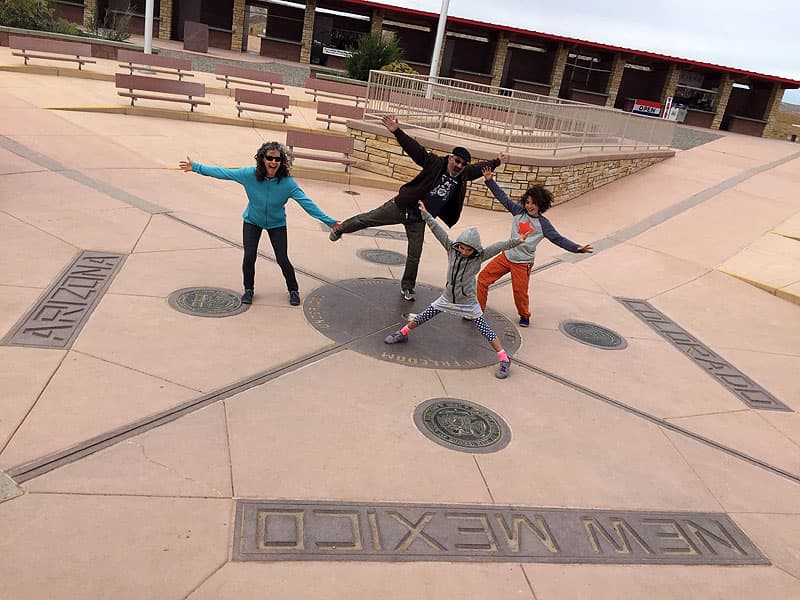
Above left to right: Ellen, Mark, Sophia, and Zachary Siminoff
We now have another remarkable story of truck camping with kids. Before their youngest was even born, Mark and Ellen Siminoff made it a priority to share their passion for travel with their children.
When the time arrived, this meant putting their own businesses on the side burner, pulling their kids out of elementary school, and making significant life sacrifices. All of this to give their kids the gift of cross-country and world travel while they’re young.
Zachary and Sophia Siminoff may not know it now, but they will benefit from their family trip in ways only the future can reveal. Who knows, maybe Zachary or Sophia will be the Publisher or Editor of Truck Camper Magazine in 2030.
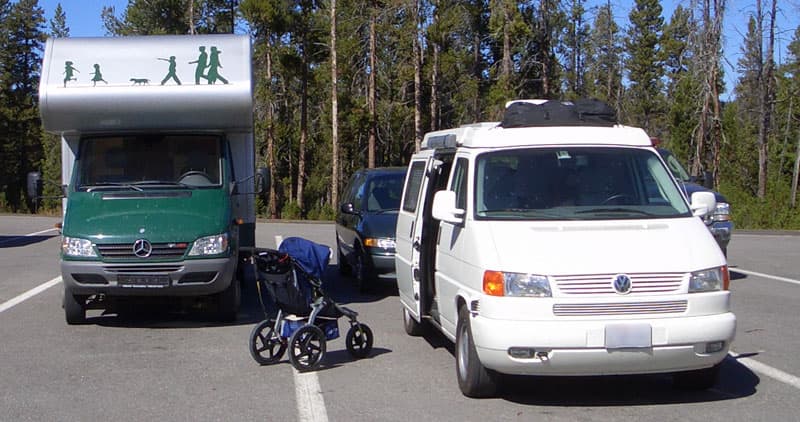
Above: On the left is the German family’s RV and right is Ellen and Mark’s 2001 VW Eurovan Camper
TCM: How did you get the idea for a ten month cross-country truck camping trip with your kids?
Mark: When Ellen and I first met, we did a lot of car camping and backpacking in a 2001 VW Eurovan Camper. We also did triathlons and went to ski resorts with our friends. We loved traveling in a really compact RV.
Ellen: When Zachary was eight months old we went on a month long trip. During that trip we met a German family who had shipped over their RV from Europe. They were traveling around the world with their three kids.
Mark and I were planning to have another kid and, when the kids were the right age, we wanted to do the same thing. About a year before we left we realized that our kids, Zachary (11 years old) and Sophia (9 years old) were the right age. It was time to go on the trip. We left on October 6, 2015.
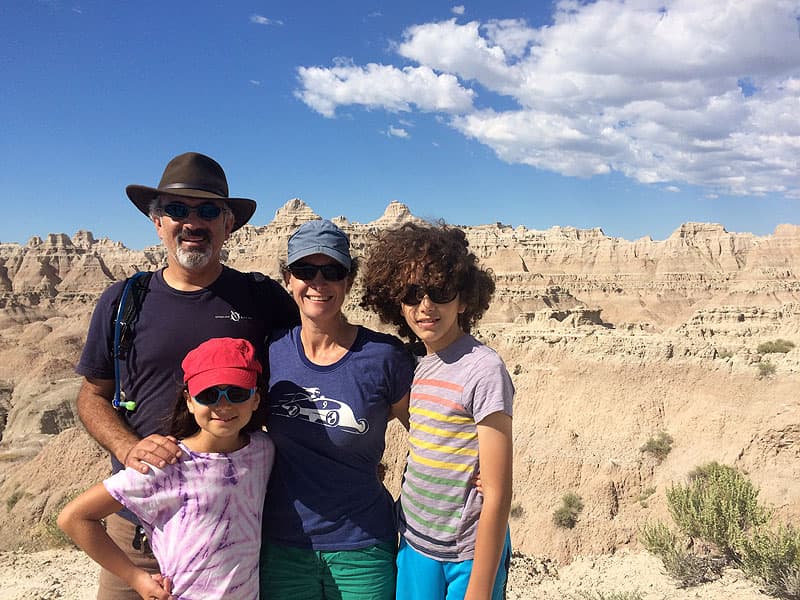
Above: The Siminoffs on the Door Trail, Badlands National Park, South Dakota
TCM: Those are some very lucky kids. How did you plan for a trip of this magnitude?
Ellen: There was more planning than I initially thought. I knew we would travel counterclockwise around the United States and into Canada. We also wanted to winter in New Zealand and Australia. We had a few other appointments, but we planned the rest of the trip as we went.
In addition to the trip planning, we had to deal with our car, rent our house, and move our stuff out. We had to get information about home schooling, and visit doctors and dentists ahead of time.
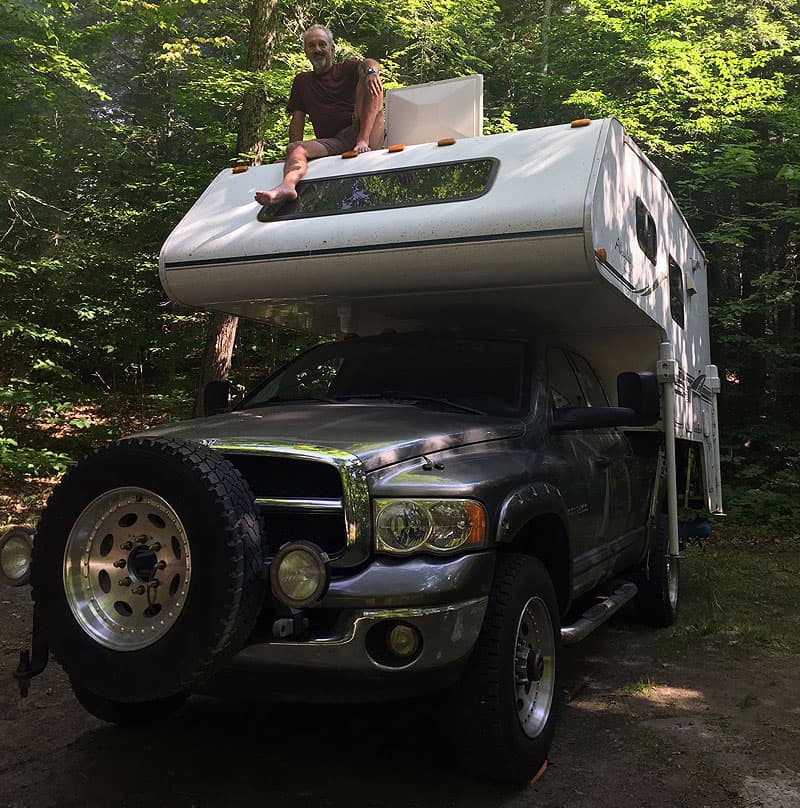
TCM: Did you need to do anything to prepare your truck and camper?
Mark: Yes, we did. Prior to the trip a lot of work had already been done to our 2005 Ram 3500 including updating the wheels, tires, and suspension.
For the trip I upgraded the transmission to be more durable, a short coming of older Ram trucks. I also bought spare radiator hoses, did basic preventative maintenance like getting the cooling system flushed, and checked the fuel injection lines. Then I took the truck in for a major service visit. That was all done before we departed.
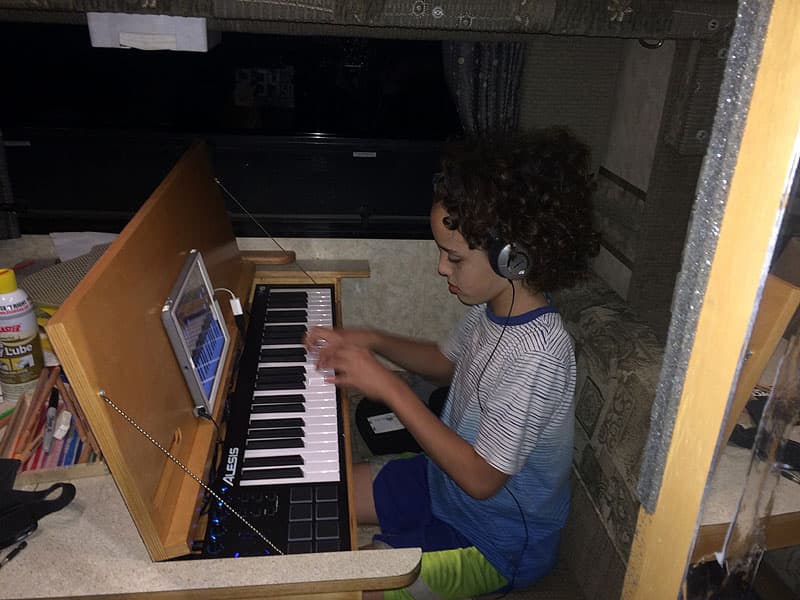
I completed a few projects for the camper including the dinette table that stores the keyboard and school supplies. That mod was done last minute because I underestimated how much time that project would consume.
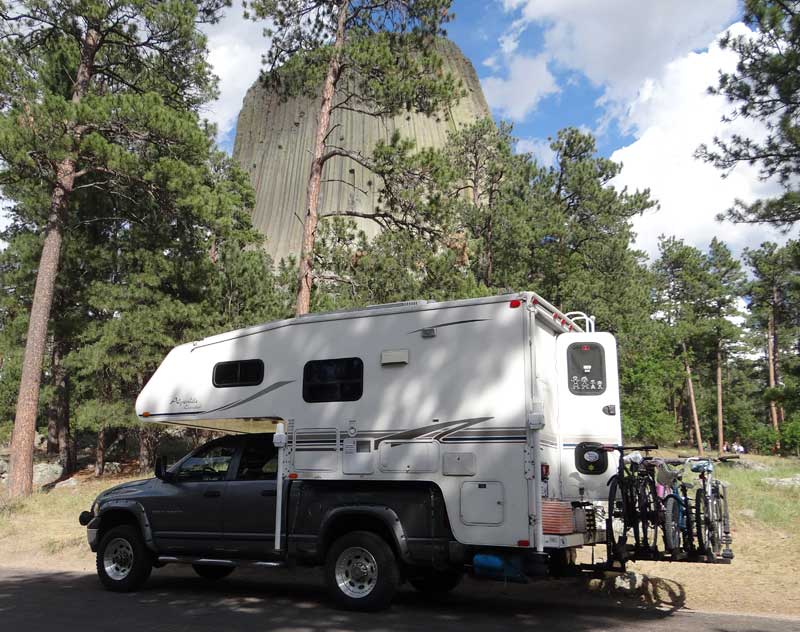
We have always hauled a bike rack behind our camper. This works, but it’s challenging to get the bikes on and off the rack. It’s also tough to access the camper’s entry door with the bikes installed on the rack. There was no commercial product that solved this challenge so I combined a bike rack from Yakima and a swinging hitch system. I designed and built our swing-away bike rack in the weeks before our trip.
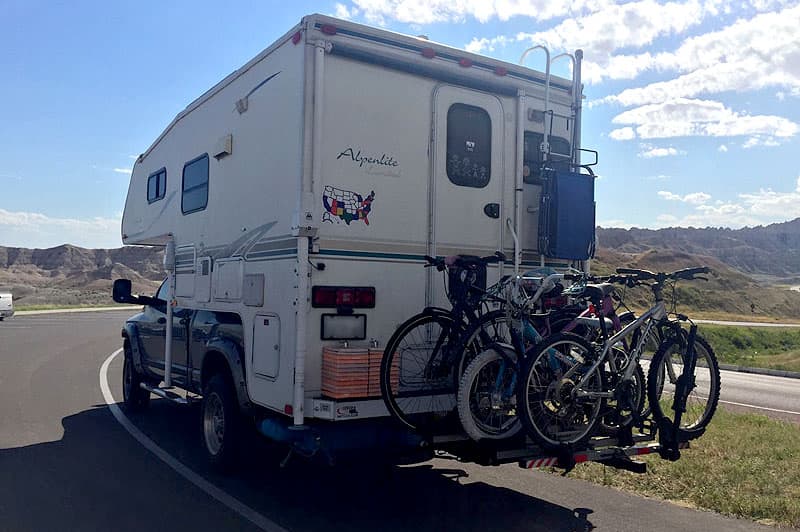
On the exterior of our camper there was some water damage. I didn’t want to start a trip like that, so I took some time and made a thorough repair. I also insulated our water tanks with electric 110-volt heating pads to prevent them from freezing in really cold weather. We used the heating pads twice on this trip.
Early into our trip we were at a restaurant and I had to look for a level place to park because the refrigerator was running. This was tricky because of the sloped parking lot. That’s when we decided to switch to a compressor refrigerator.
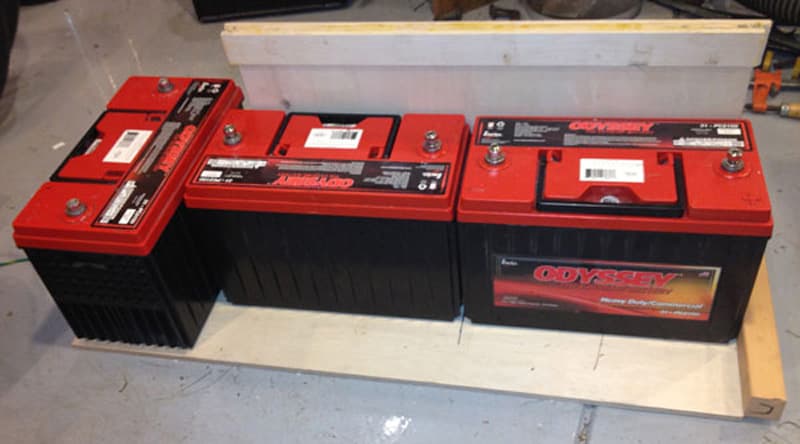
That was a game changer. Our camper has 325-watts of solar and 300 amp hours with our Odyssey AGM batteries. With that combination, we don’t worry about power even though I check the monitor all the time.
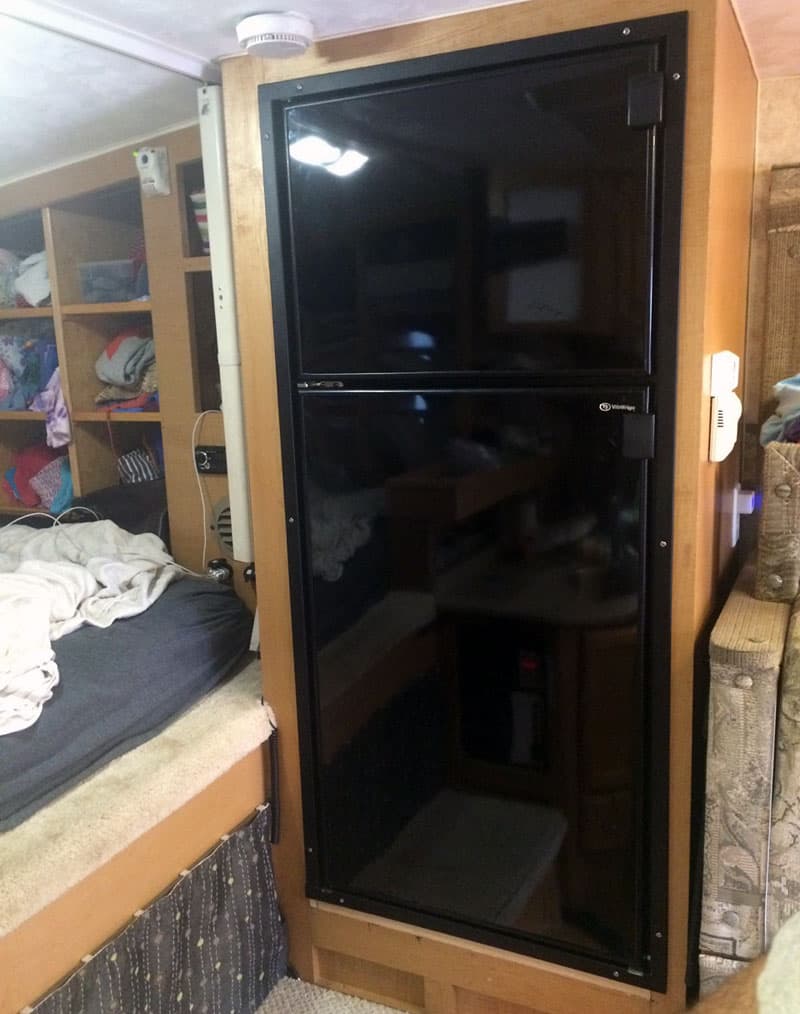
Getting the compressor refrigerator meant that we didn’t have to worry about being level. The reality is that you are sometimes parked in driveway and it has a 15-degree slope, so you can’t leave a standard RV refrigerator on. Now we don’t put a thought into leveling. But, we also have a ton of power sources, so the compressor refrigerator works for us.
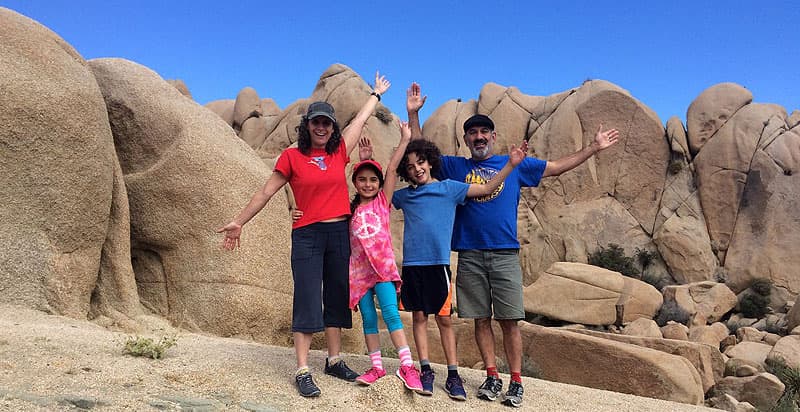
Above: Joshua Tree National Park, California
TCM: How did you manage to pack enough clothing and stuff for four people?
Ellen: Before we started the trip we took a hard look at everything in our camper. For example, we looked at the utensils and asked, “What are we going to actually use?” We didn’t realize it, but we had accumulated a lot of clutter from weekend camping trips.
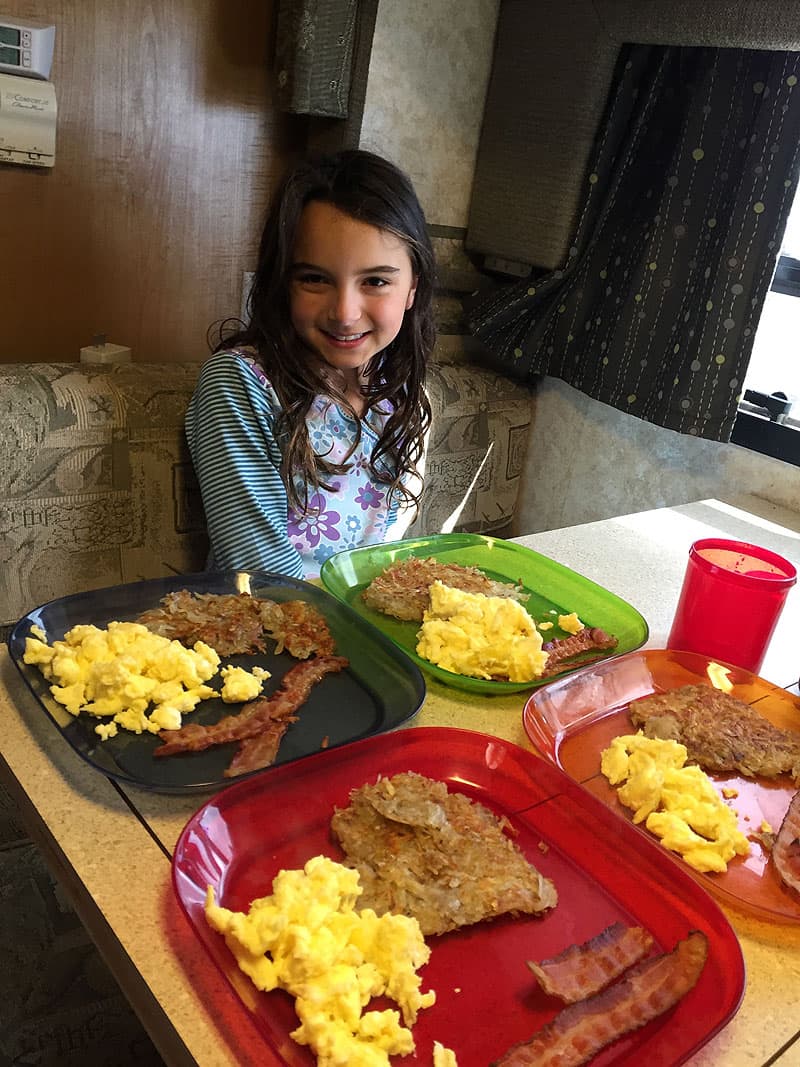
To help with organization, we decided to color code everything. We all have plates and cups with different colors. That way, after a meal we knew who left their plate out. With our towels we sewed colored loops on them. They were the same colors as our plates.
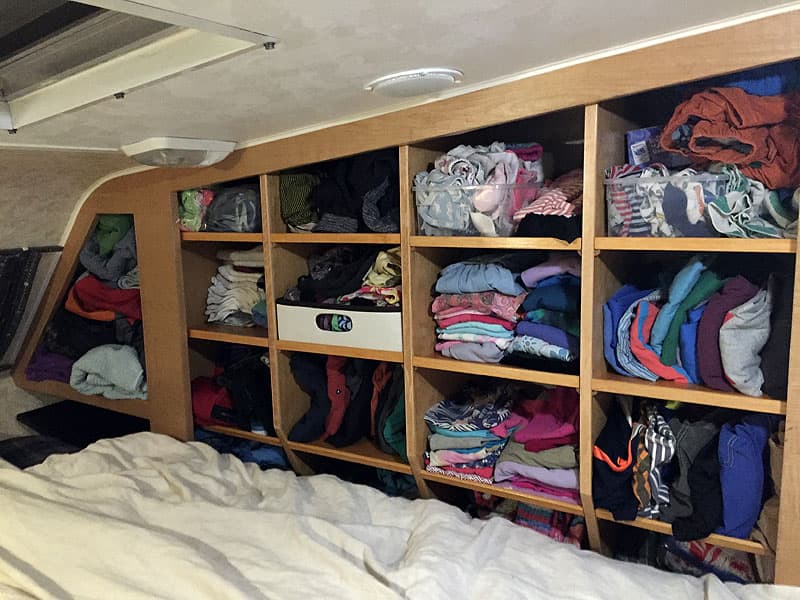
We also have our cubbies in the cabover, another mod Mark did a few years ago. Each of us has a column of four cubbies when we go camping. For this trip, we each had to decide what we wanted in our cubbies; clothing, books, toys, etc. If it didn’t fit in the cubbies, it didn’t go.
Mark: We also had some rules. If you weren’t using what was out, it had to go back in a cubby. Work stuff had a cubby. Toiletries had their space in a cubby. It was organized so that we could just grab the shower cubby’s contents and go.
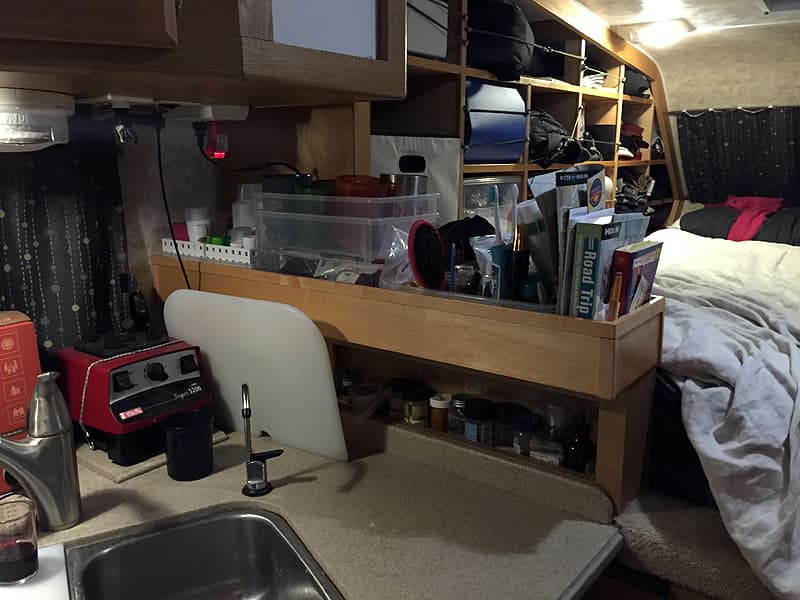
Ellen: It’s not like all of this was set it all up before we left. We actually stopped at a Container Store in Austin, Texas. At that point we knew what was working and what was not working. We picked twenty containers and, with the help of a Container Store representative, tried things out in our camper. We bought what fit; a magazine rack by the door, a toothbrush container, and some other items.
I’m fine with close quarters as long as it’s organized. We organized most of our stuff before the trip, but we knew changes would be made as we traveled. It didn’t need to be perfect when we left.
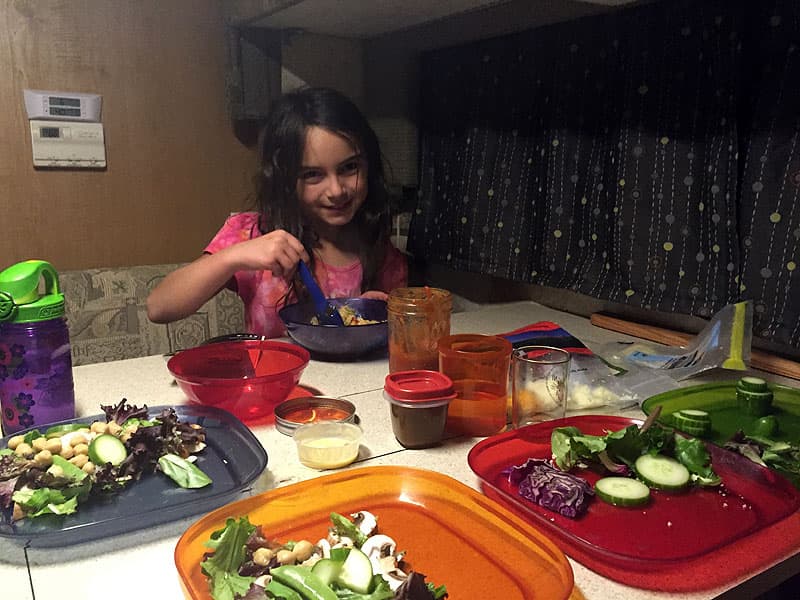
TCM: Did your family of four feel claustrophobic living in a little truck camper?
Mark: We’re a really tight family and love being together. In general, no one felt claustrophobic, but we are humans and need personal time.
When we go to the beach, Ellen might rent a kayak and the kids and I might do something else. My thing was bicycle rides. Ellen did more of the home schooling, which is when I’d hop on my bicycle.
When the weather was good, we used our camper only for meals and sleeping. If weather was bad, we’d huddle inside, but we didn’t have many of those days. We felt like the camper was our cozy nest.
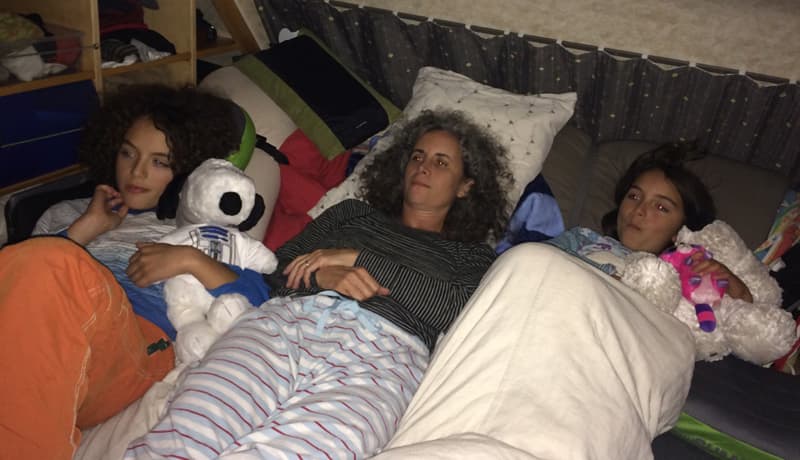
Above: Movie night in their truck camper’s cabover
We had a couple nights where we all snuggled in the cabover bed, made popcorn, and watched a movie. We had as much fun with that as going on a hike or to a museum. A couple days before going to Devils Tower in Wyoming we rented Close Encounters and watched it.
TCM: That’s a great idea. Somewhere on the internet there’s probably a list of movies to watch before you visit certain destinations. How did you manage things that you picked up along the way?
Mark: Four times during the trip we filled big boxes, and shipped stuff back home. We shipped back clothing, cooking stuff, and a gigantic coffee press. That is stuff that takes up space and we could do without.
Ellen: Sometimes the kids would buy something and use it, but then realize it was something that they’d use at home later. So we’d ship it home. I saved papers and maps from museums to later make into a scrapbook. I put them in the mail and sent them home. I am now finishing up four giant 4-inch thick scrapbooks from our trip.
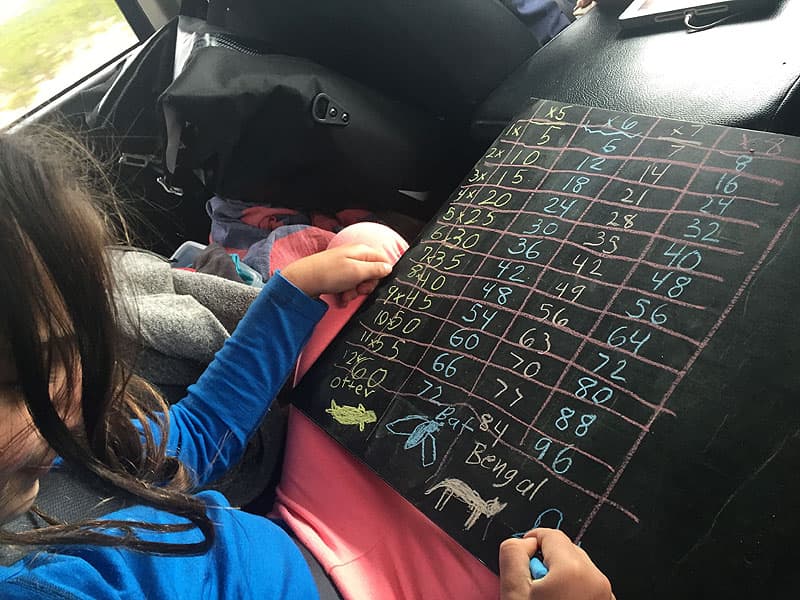
TCM: How did you homeschool Sophia and Zachary on the road?
Ellen: They go to a Waldorf school and have the same teacher from 1st through 8th grade. That was a benefit for us because it gave us the confidence that they would be okay academically. Before the trip, I met with each of their classroom teachers and special subject teachers and gathered materials.
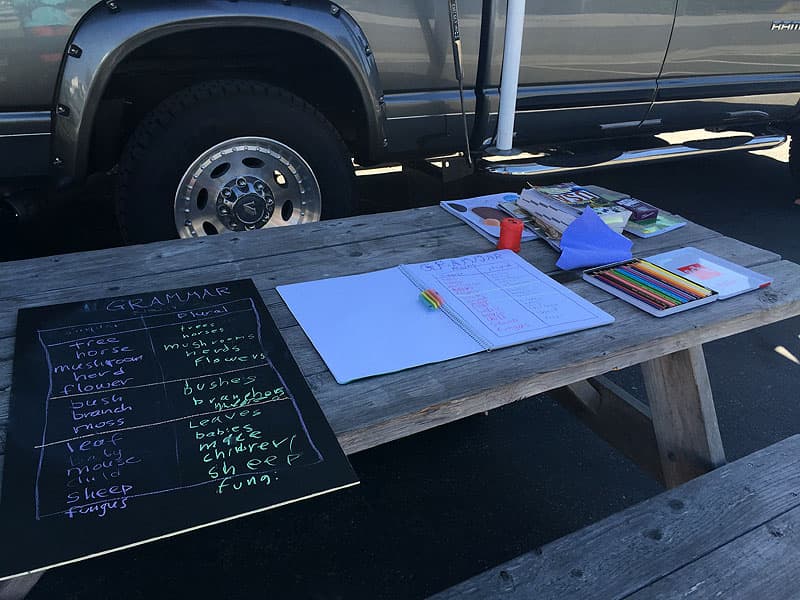
We started the homeschooling before we left home. They weren’t super excited about it, but did okay. Once we left on the trip, homeschooling was more difficult. We were so busy that it was challenging to make enough time for homeschooling. I talked to their teachers and they said to have the kids read, write in their journals, and do math everyday. So that’s what we did.
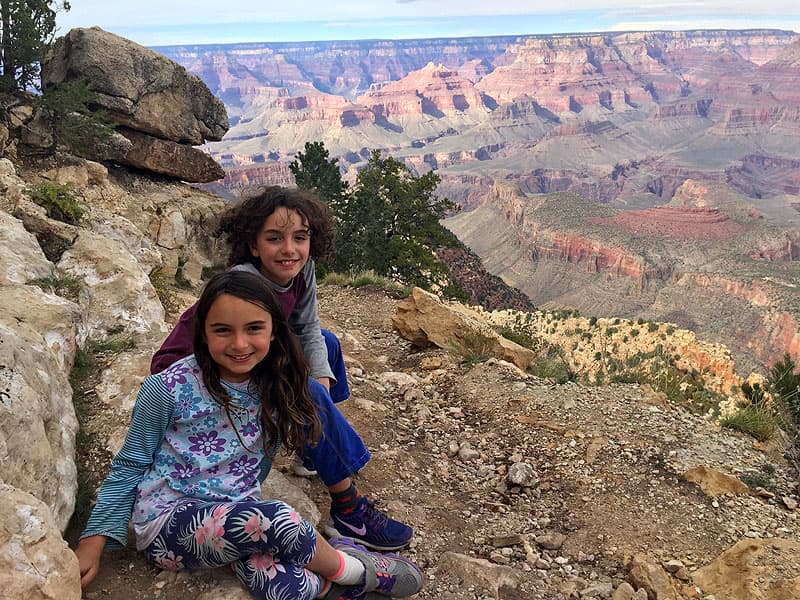
Above: Mather Point, South Rim, Grand Canyon National Park, Arizona
The kids had this amazing experience and they have learned so much. It was different from what their friends at school were learning, and that’s okay. They now have life experiences that they’re going to take with them their whole lives.
The kids are now back in school and doing fine. We’ve had lots of compliments from teachers and parents about their social development and interpersonal skills. The life experience of interacting with people has noticeably matured them.
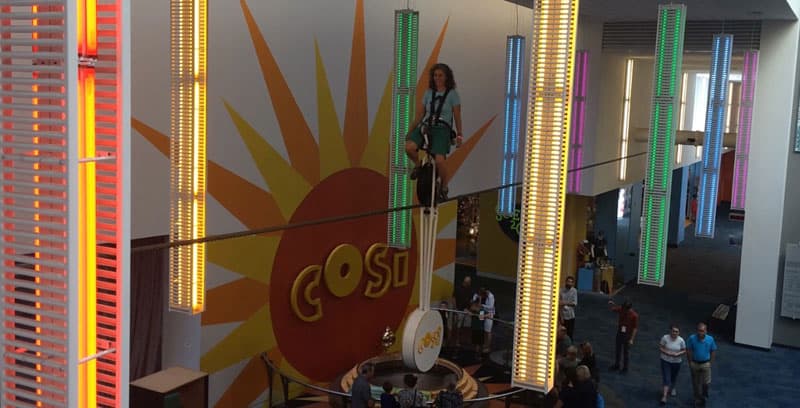
Above: Ellen riding the high wire unicycle in the COSI museum
TCM: During the trip, what were some of the best learning experiences for the kids?
Mark: We focused a lot on museums. If there was a children’s learning or science museum nearby, we would go. We made a four hour detour to Columbus, Ohio to go to the Center for Science and Industry museum (COSI).
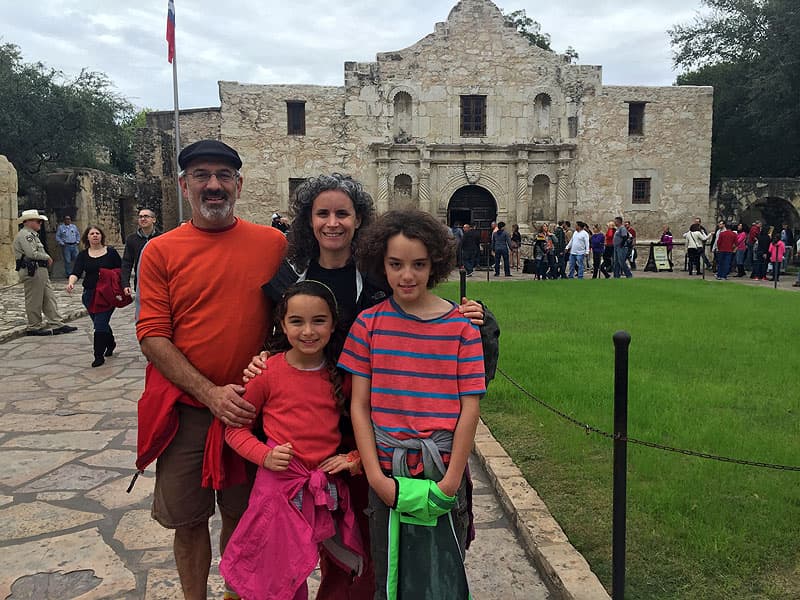
Above: The Alamo, San Antonio, Texas
Ellen: We also went to places like the Texas state capitol and The Alamo. During those stops the kids learned a lot of Texas history, and had an experience they couldn’t get in California.
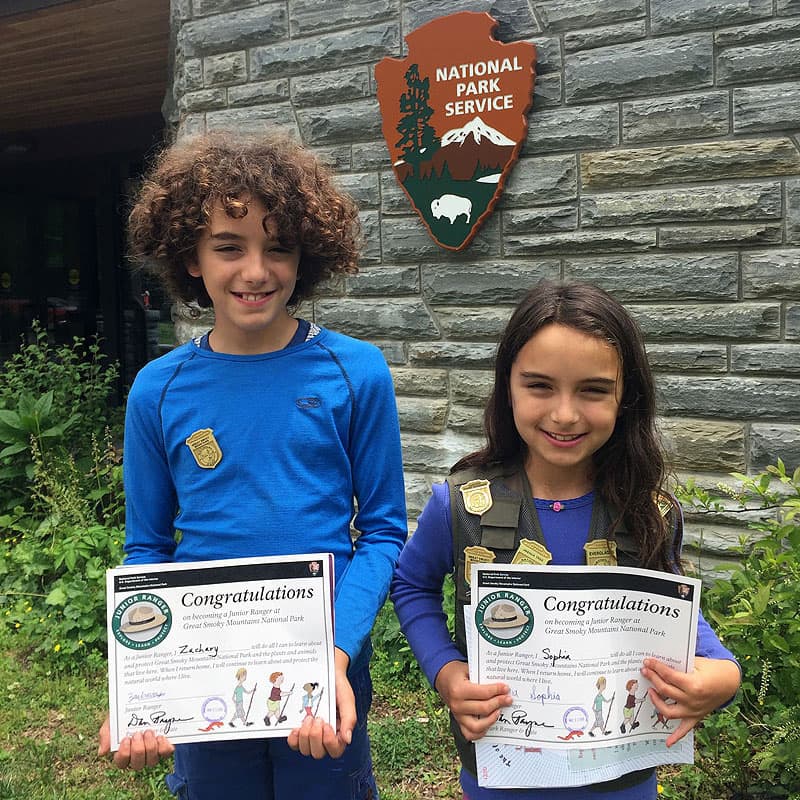
Mark: They also enjoyed the ranger led programs at the National Parks. We bought a National Parks yearly pass so that we could go to lots of National Parks. The kids really enjoyed the Junior Ranger program.
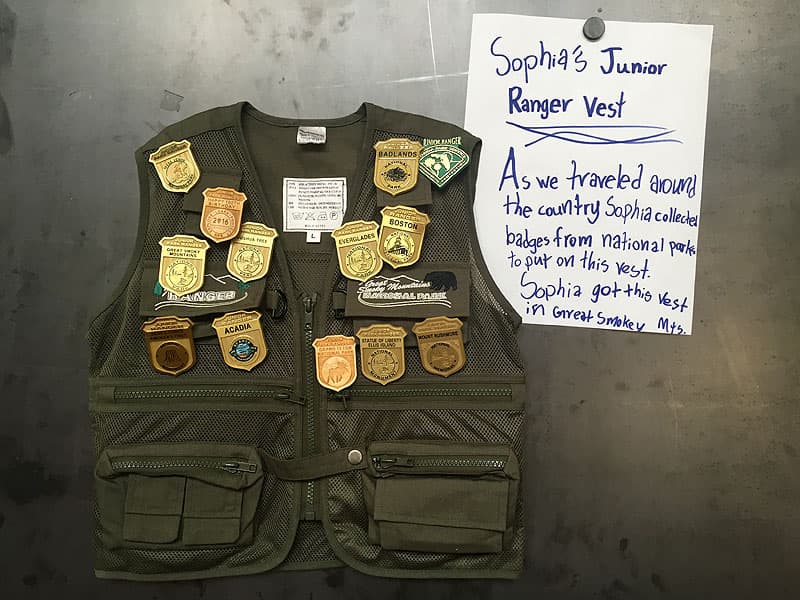
Ellen: The National Park programs are spectacular. Ranger talks and walks are always worth it. All of us were interested and got a lot out of those programs.
When we were walking around Asheville, North Carolina, there was a statue on the corner. The kids said, “What is this about?” We read the plaque, and talked about it. Experiences like that gave us the history of the area we were exploring.
Mark: Road magic was wrapped up in those experiences. We were in Louisiana and a friend in California had grown up there. His great, great uncle owned a plantation, so we made a detour just to visit the plantation.
Ellen: The kids also learned how to interact with others, and how to present themselves. They learned that you can’t be shy when you’re only visiting for a few hours. They had to jump in, say hello, and look people in the eye. That was a social skills education. We called it road schooling.
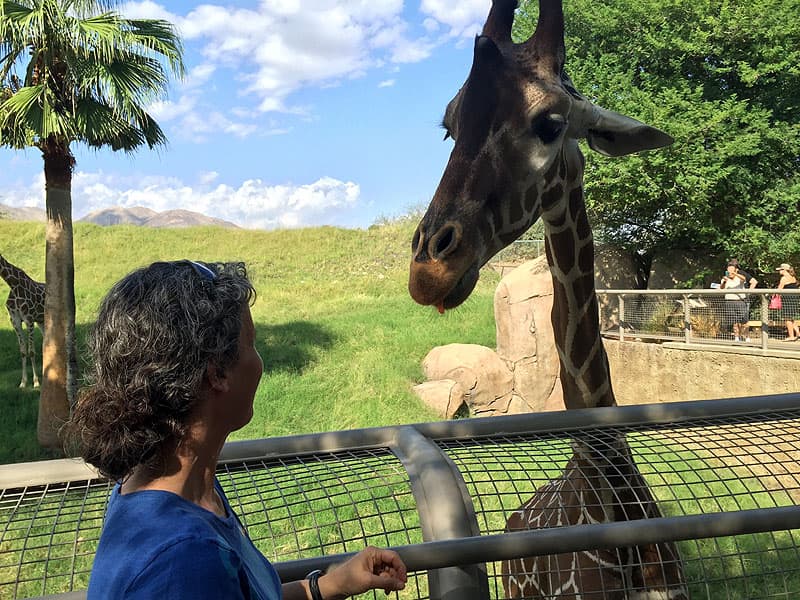
Above: Living Desert Zoo and Gardens, Palm Desert, California
I learned a lot on the trip as well. I learned a ton that I didn’t know and saw things that I studied in school 20 to 30 years ago. Going somewhere and experiencing it first hand is very educational.
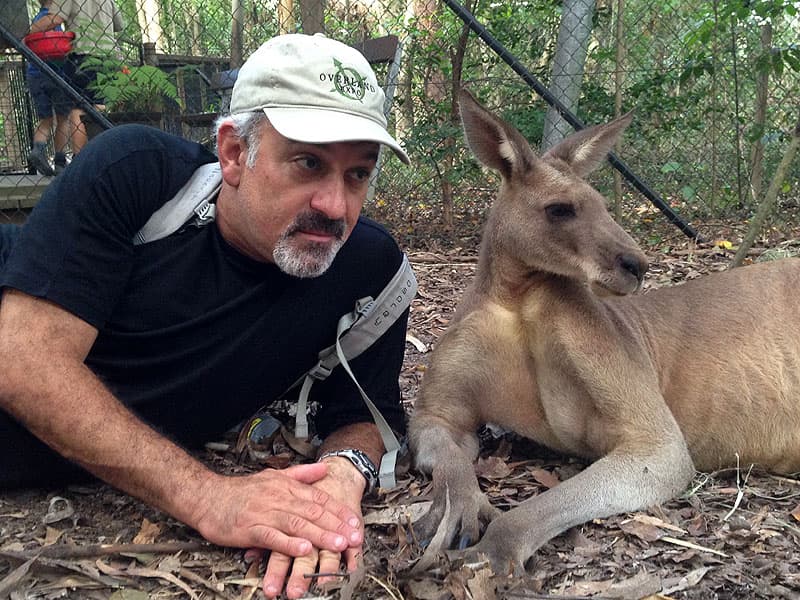
Above: A very friendly red kangaroo at Hartley’s Crocodile Farm, Port Douglas, Australia
TCM: There can be no doubt that your kids learned a tremendous amount traveling around the United States, Canada, Australia, and New Zealand. How were you able to leave your jobs for the better part of a year?
Ellen: We are blessed in that we both have our own businesses. I run a design consulting business with a very capable business partner.
I put a plan in place a year before we left. First, I reduced my number of clients and promoted a long-term employee to do creative tasks. Then I hired another employee to do the administrative stuff. On the road, I checked in once a week. Once in awhile there were things that only I dealt with, like taxes. It wasn’t perfect, but it worked out.
Mark: Ellen and I have the two greatest business partners on the whole planet. They knew a year ahead and both independently signed up to run the businesses while we were away. Not many people would take on that additional workload, but our partners did.
We were pretty much always connected to the internet. We both have smartphones and can tether, so we were in contact almost every day by email. Once a week we had a phone call to go over the status of the businesses.
Ellen: We live in Silicon Valley and we rented our house during our trip. A friend managed the rental for us. We moved about 30-percent of our stuff – the things we really cared about – into the garage and locked it. The rest was left in the house.
We figured some of our stuff would get damaged and to not worry about it. The cost of moving everything and storing it would be higher than the replacement costs. Our friend checked in after each renter to see if anything had happened.
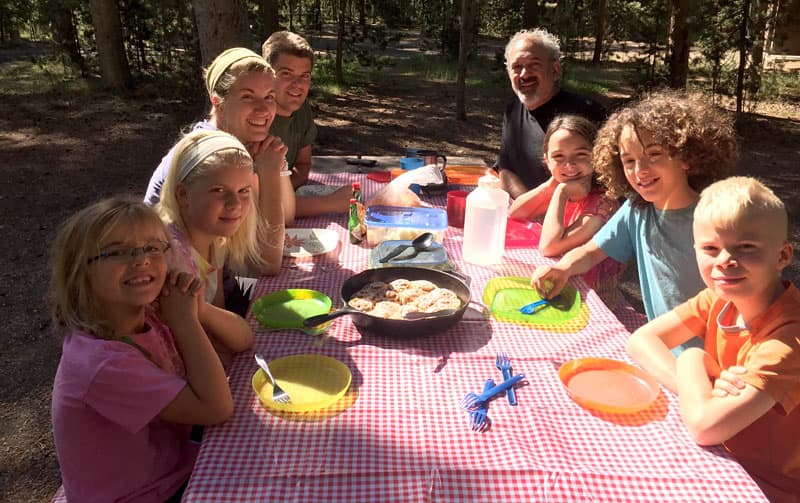
Above: Camping with the Currens in Yellowstone National Park, Wyoming
TCM: Let’s get to your trip. What were some of the highlights?
Mark: By the time we got to Florida we had been on the road for over two months and we had gotten into a funk. Then we met two amazing families that lifted our spirits. One family had three children and had been living full-time in their Airstream trailer for two years; homeschooling and traveling. They were truly full-timing it. Here’s their website: currentlywandering.com.
Ellen: I am so glad we met them because they were amazing! Prior to meeting them, the kids weren’t interacting with other kids on the road. Then I saw this family at their campsite and we hit it off. Everybody got along instantly.
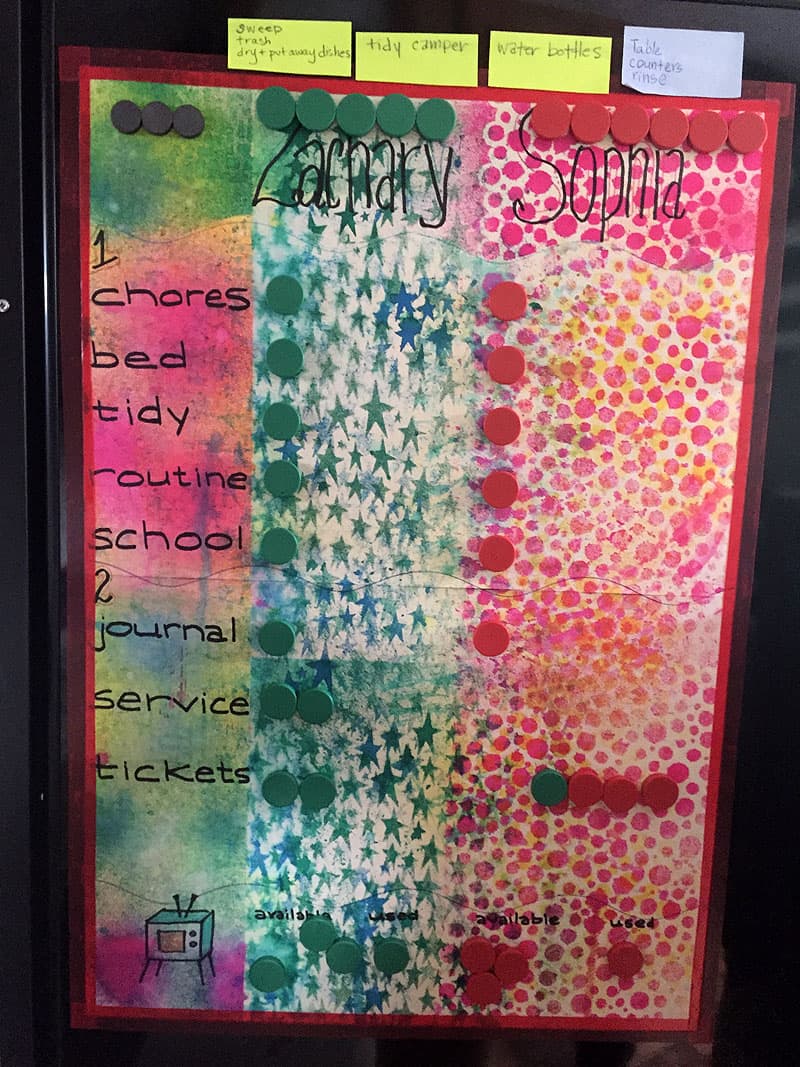
Mark: This wonderful family recognized our struggles as their struggles two years before and took us under their wing. The stuff we learned in a couple of days was magical. With their suggestion, we started our daily chore list on the refrigerator. It ranged from school work to dishes. This idea really worked for us.
That experience totally changed our traveling. We met up with this family several weeks later in northern Florida and then in Yellowstone. That was magical for us.
Another road magic moment came when we were planning our trip to New Zealand in mid-February. We hadn’t done much planning, but knew we were going to have to park our rig somewhere. Then, we met a family in a campground and talked about our upcoming trip to Australia and New Zealand. They asked us where were going to store our rig, and then offered to let us keep our rig at their house in Atlanta.
I said, “Are you sure? My camper is big.” He said, “We have room, so there’s no issue. It’s free for as long as you want.” That was very lucky. We had a safe place for our camper for three months and we didn’t have to worry about it at all.
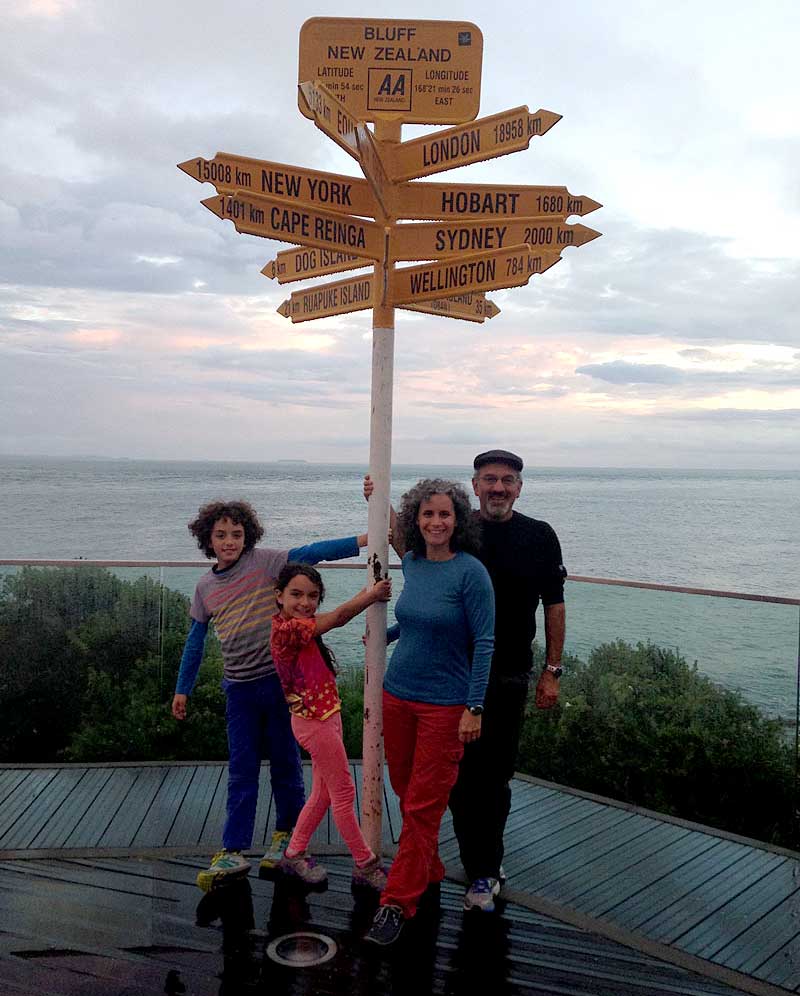
TCM: That is extremely lucky. Where did you typically camp every night?
Mark: Depending on where we were in the country depended on where we camped. I’ll start by saying that I generally dislike camping in parking lots. We did that maybe four to five nights of the entire trip. The times we chose to go to Walmart or Cracker Barrel were the times we got in late and then got on the road early in the morning.
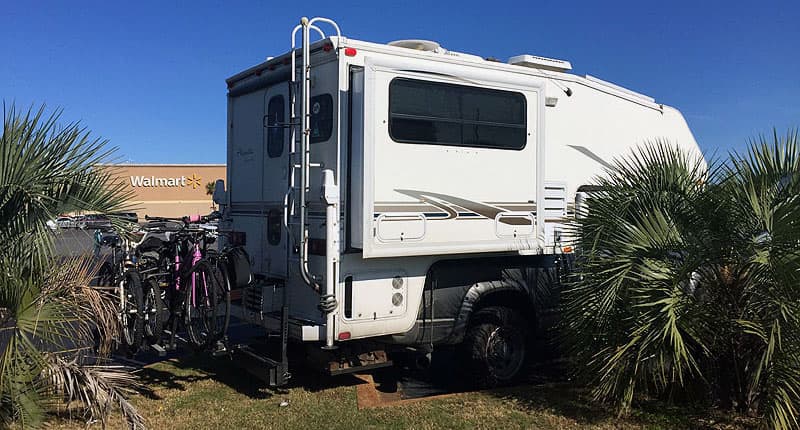
Ellen and I have never been Walmart shoppers, but I have a new found appreciation. They are welcome to having RVers overnight. If you pull in at 1:00am, it’s open 24 hours, so you can go in and get whatever you need. I generally felt very safe at Walmarts.
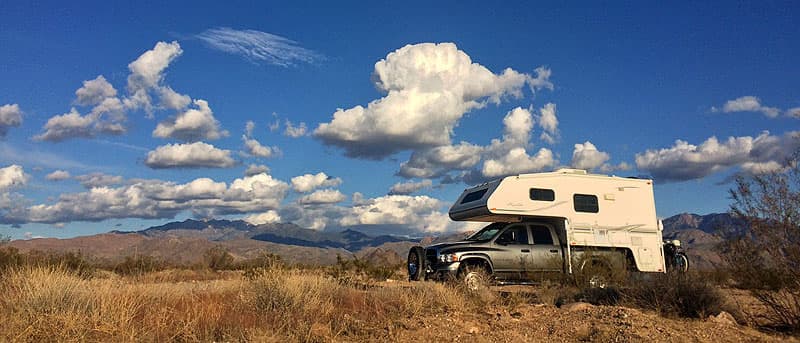
Above: Sage Creek Road in Badlands National Park, South Dakota
We like to dry camp in forests or desert areas. We like to go off the beaten path. I would always prefer that, but that style of camping is not available everywhere.
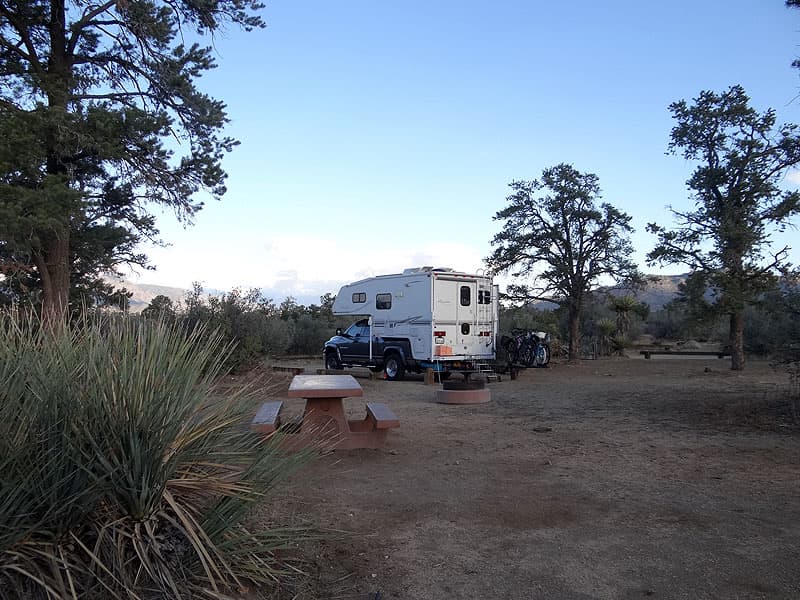
Above: Pinon Flat Campground, Mountain Center, California
In the northeast, we stayed in state forest campgrounds where there was nothing but a fire pit and picnic table. In the west there is a significant amount of BLM land that allows dry camping for up to 14 days, and is mostly free.
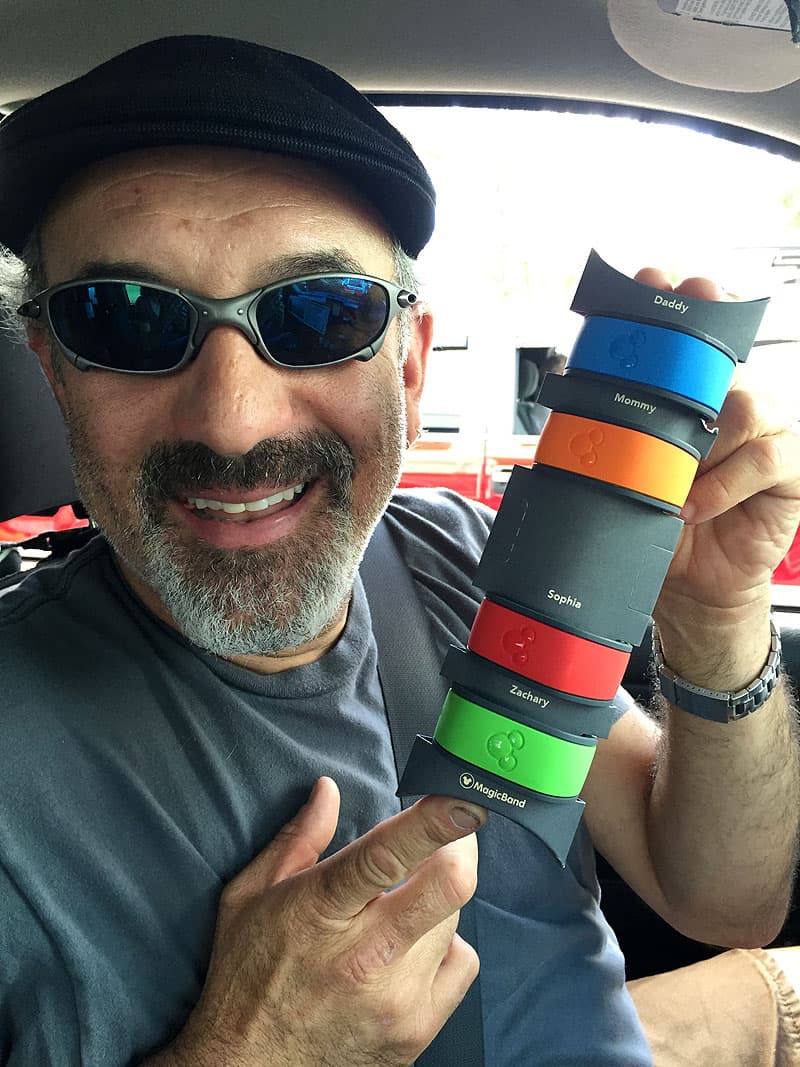
We also stayed in some monster RV parks. When we were at Fort Wilderness in Disney World, we left our rig in the campground, hopped on a bus, and arrived at the Magic Kingdom. There is so much convenience to those bigger parks.
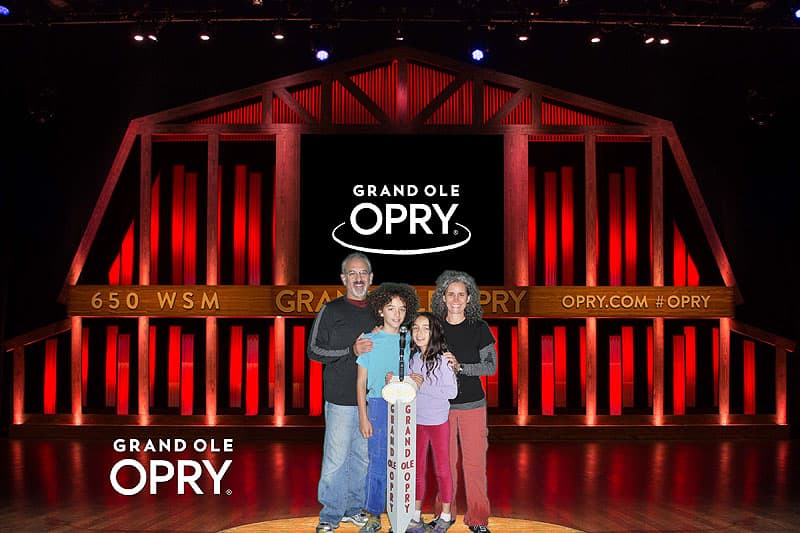
We also stayed in a KOA when we visited the Grand Ole Opry. We were a mile away and they had a shuttle service. Staying in a campground is like staying in a hotel with the internet and full hookups. And you have the ability to fill your tanks and take a hot shower.
Visiting people helped to break up the routine of living in a truck camper, even though we typically slept in our camper while we visited them. It was good to not be in campgrounds all the time. It gave the trip a lot of diversity.
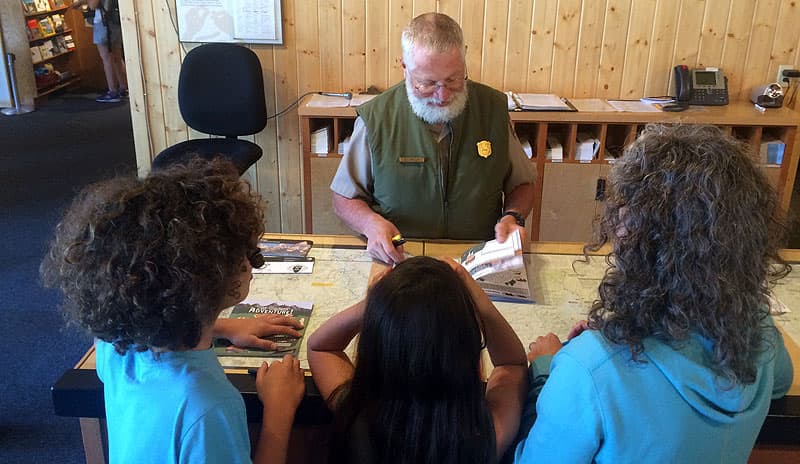
Above: Visiting TCM contributor, Bryan Appleby, at a National Park
TCM: How did you go about finding places to camp and things to see everyday?
Mark: We did all of our navigation through our iPad. With a tablet device connected to a cell network, we had real time traffic. We could find activities, campgrounds, or museums because we were always connected. If Ellen was reading or sleeping, I’d be able to navigate. If we were somewhere more challenging, she would use it as her dashboard computer. That helped a lot.
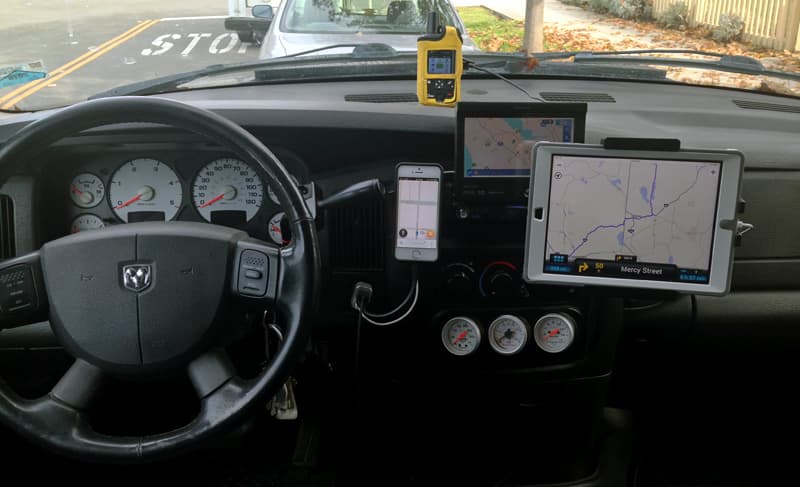
Above left to right: iPhone 5, Delorme InReach SE satellite communicator, in the center is an in-dash Pioneer AVIC-N3 which is a GPS navigation system, AM/FM radio, Satellite radio, DVD player (we have a screen on the ceiling of the truck), and it also has an iPod interface, and on the right is my iPad Air.
The iPhone and iPad are attached to the dash with mounts from ProClip. The phone is in a case & mount from Quad Lock.
I picked up a long range WIFI antenna from Ubiquiti Networks. It allowed me to connect to WIFI connections over a mile away. That was also very helpful.

Above: The Ubiquiti Air Gateway
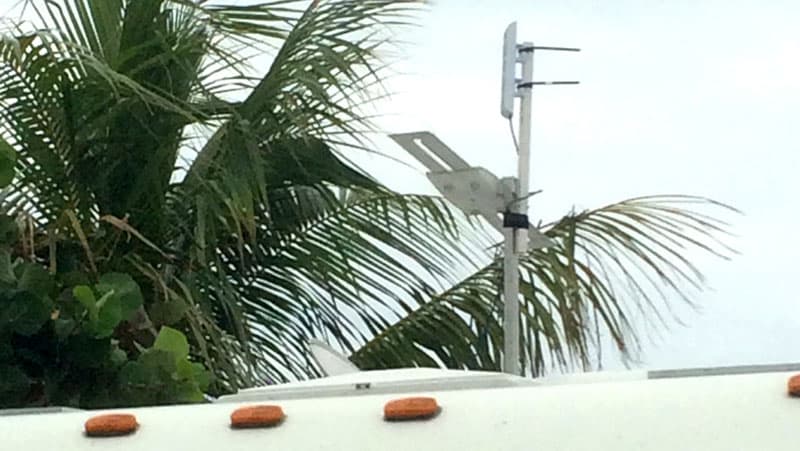
Above: The Ubiquiti NanoStation antenna on the roof of their camper
There were times in the Florida Keys that I could get an internet connection from across the waterway at a restaurant or at a Starbucks half a mile away. If you’re a Comcast customer, there are access points all over the place.
I did bring a Delorme InReach. I used it to track our course. It updates every ten minutes. We never once used it for communication. It did give us peace of mind. Delorme uses the Iridium satellite network, so every single inch of the world is covered. For me, the prices are similar between Spot and Delorme, so it was a no brainer since the Delorme offers two-way text or email communication.
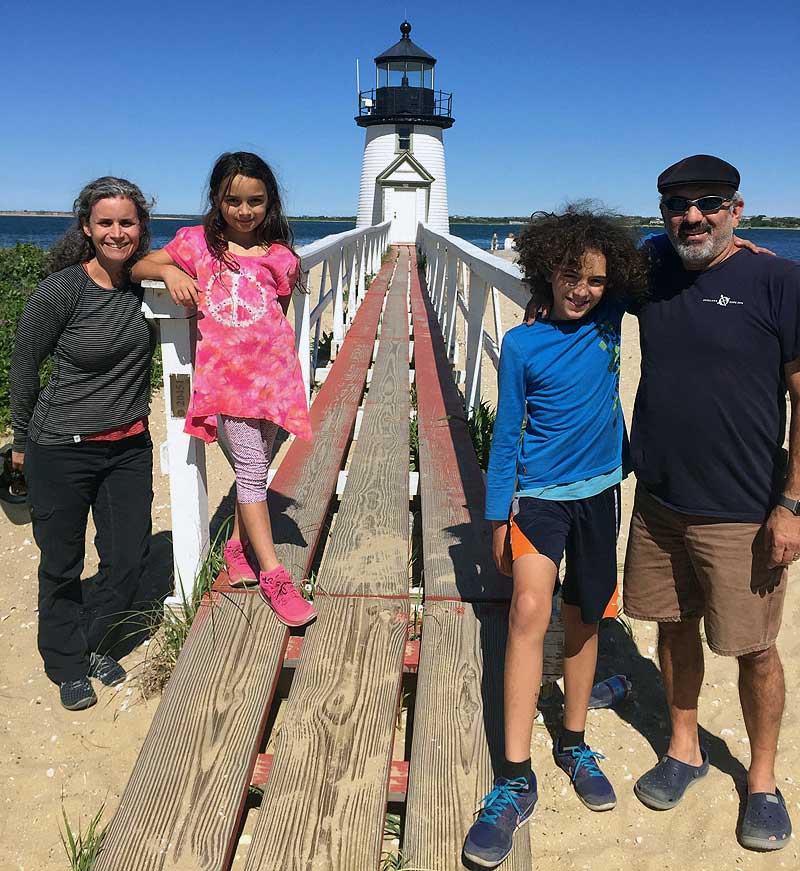
Above: Brant Point Lighthouse, Nantucket, Massachusetts
TCM: How does it feel being back in a house again after being on the road for so long?
Mark: A lot of people have asked about departure and reentry. We had prepared for the worst, but it really wasn’t bad. The kids were thrilled to be back at school. They had missed their friends, and so had we. Being able to reconnect with our friends has been really special. By the time we got home, it felt really normal.
The four of us lived in about 64 square feet for ten months. About five months into trip, Zachary commented on the little amount of stuff we lived with in the camper. He said, “Dad, why do we have all that stuff at home when we have everything we need with us?” You get used to living with less stuff, and it’s perfectly comfortable. We didn’t feel like we were missing out because we didn’t have a lot of stuff. I was fine with one pair of shoes. You can live with a lot less.
It was harder for Ellen and I to shift back to work. That’s probably been more of an adjustment than anything else.
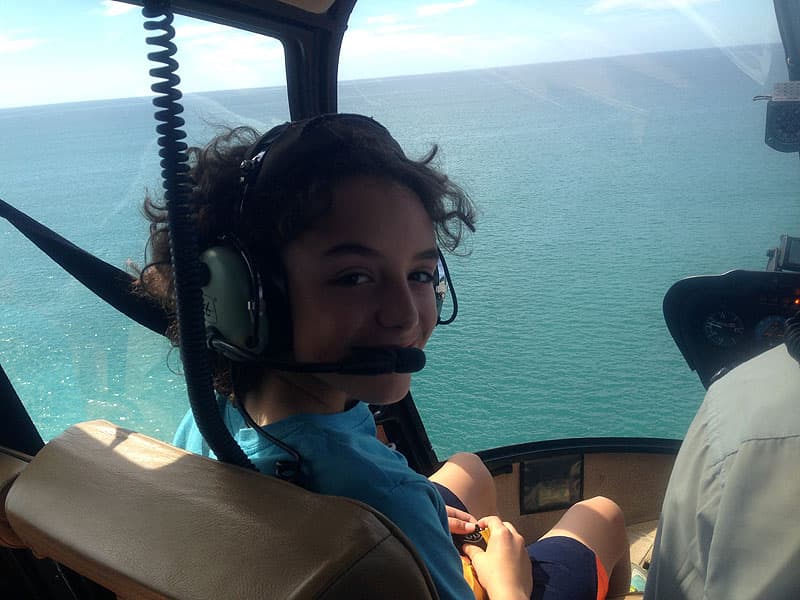
Above: Zachary’s first helicopter ride in a Robinson 44, Kaikoura, New Zealand
Ellen: Honestly, it feels like we never left. I have a nice home and life, so it wasn’t like the trip was escaping anything. It was just a different experience.
One thing I will say is that we all felt special on the road, like you do when it’s your birthday. We could go to a museum or a beach on a Wednesday in the middle of the day. We could do what we wanted to do, when we wanted to do it.
In real life, we have to do those things on a Saturday, and maybe three weeks from now. When you’re traveling, you can do it whenever you want. When we were traveling we’d get into conversations, and people asked what we’re doing. Some people thought it was amazing and some thought it was crazy. Now that we’re home, we’re back to being normal people.
TCM: For most folks, what you did is amazing, and a little crazy. Would you do a trip like this again?
Mark: In a heartbeat.
Ellen: Yeah, I would. Looking back, I wish I knew then what I know now. If there’s one piece of advice for other parents looking to do something like this, it’s to talk to other families who have traveled this way before your trip. They will explain the things you need to know. Then again, there’s something to discovering what works for you and your family.
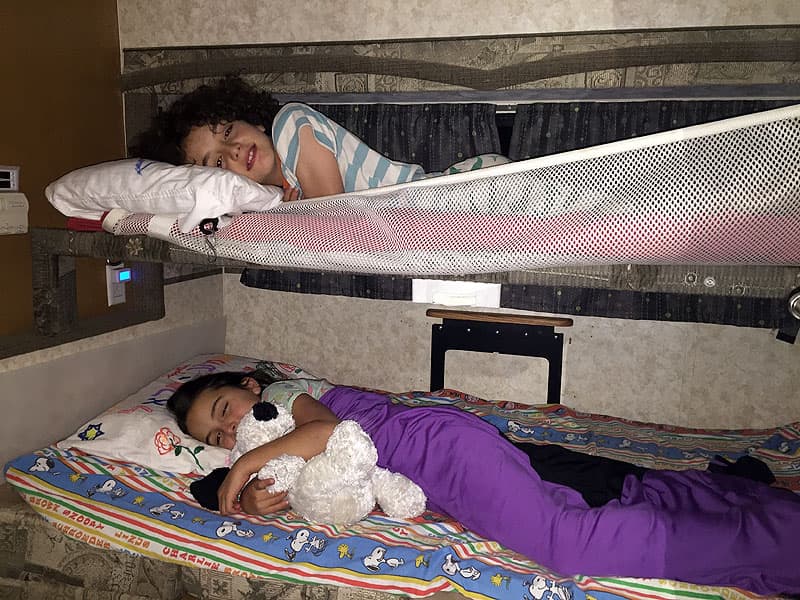
Mark: Having spent ten months in a camper with my family, I have ideas on a truck camper design. I think truck campers are far better than motorhomes or towables.
A big challenge for anyone with children in a small RV is taking down the dinette and getting the bunk beds set up. Once that’s done, Ellen and I lose our place to socialize or to do our work. We also lose the table to sit at to eat. The single biggest feature of my new camper design is a dedicated space for bunk beds and a dinette. Once people go to sleep, the dinette is available for card playing or whatever.
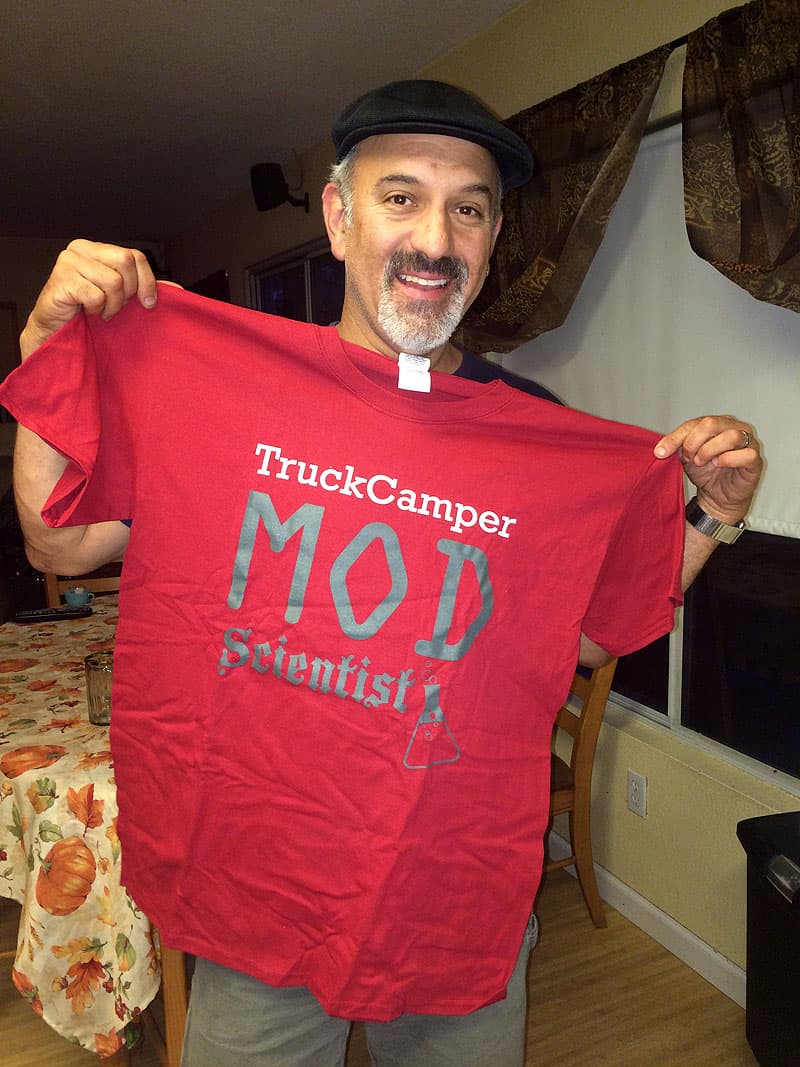
TCM: That’s intriguing, especially coming from a multiple mod contest winner! Let us know if you build your dream camper. Is there anything else you want to share from your amazing trip?
Ellen: My favorite part of this adventure was the opportunity to meet friends and family we might never of otherwise visited, or been able to make a special trip for. We would park and stay in their driveway, or get together for a meal.
When we stayed with people, it was so amazing to see how they were living. We got to visit and spend time with people the way we never got to before. That was the magic for me.
My dad’s family is from Detroit. My family was the only one that moved to California. I had never met them. We stayed with my cousin and her daughter. I met lots of family members and they pointed me to other family members. Then, my cousin in Michigan came to visit us here a few weeks ago.
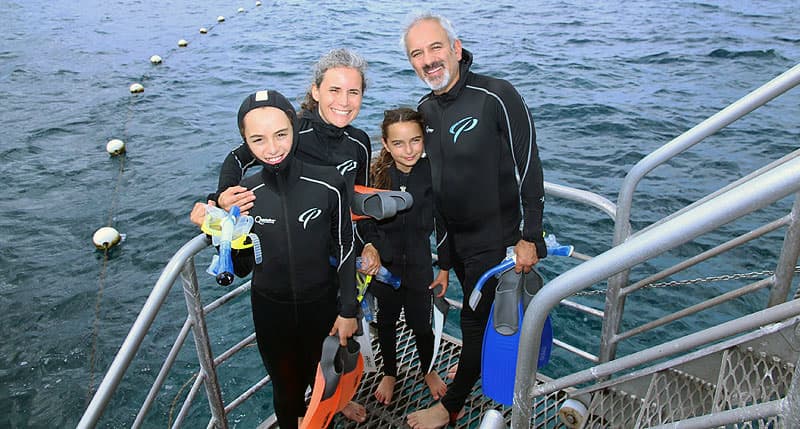
Above: Agincourt Reef, Great Barrier Reef, Port Douglas, Australia
Mark: Despite what our media says, this country is a safe place with welcoming people. We went scuba driving, ocean kayaking, flew in helicopters, and went bicycling. Those might be dangerous, but they are dangers of our own choosing. We had zero issues with family safety.
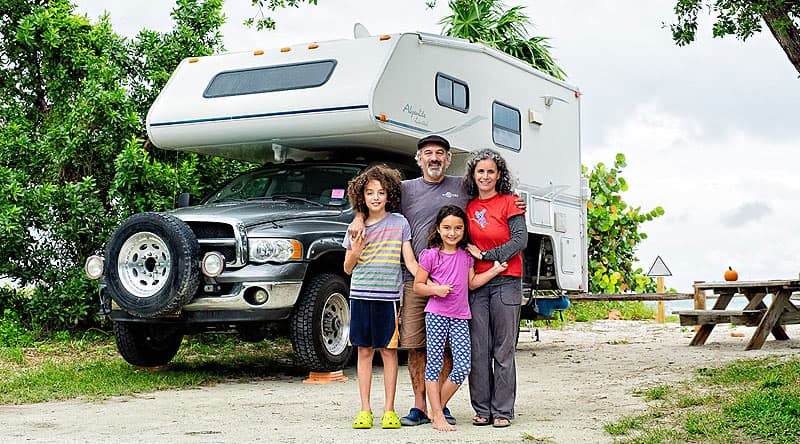
Ellen: A bunch of people have come up to me to say they were inspired by what we were doing. They told me that they did something out of their normal comfort zone and now have great adventures based on what we did. The German couple we met years ago doesn’t realize that they inspired us, and now we get to inspire others.
Mark and Ellen’s Rig
Truck: 2005 Dodge Ram 3500, 5.9L Cummins Turbo Diesel, Crew Cab, 4×4, Single Rear Wheel, Short Bed
Camper: 2004 Alpenlite Saratoga 935
Tie-Downs/Turnbuckles: Torklift FastGuns
Suspension: Vision Type 81 19.5” wheels, Bridgestone M729F (245/70-19.5) tires, Rancho RS900XL shocks, Firestone Ride Rite airbags, Roadmaster rear anti-sway bar, custom rear upper and lower bump-stops, Suspension Maxx front anti-sway bar end links, Thuren Engineering track bar and tie-rod end, 2008 Ram steering linkage, Dynatrac Free-Spin hubs, Dynatrac ball joints.
Truck Gear: Goerend 48RE transmission (billet shafts throughout, triple disc torque converter), PacBrake PXRB exhaust brake, on-board air compressor and tank (for airbags, exhaust brake, horn,& tire fills), 7” HID off-road lights, 4” HID off road lights, bumper mounted spare tire carrier, Smarty programmer, grid-heater delete, Pusher intake horn, DC Power Engineering 180A alternator.
Camper Gear: Three Odyssey PC2150 AGM batteries (300Ah total), 328-watts of solar panels, (2) Morningstar SunSaver MPPT charge controllers, Prosine 2.0 inverter/charger, Torklift GlowStep with landing Gear, Vitrifrigo DP2600 compressor refrigerator, Dometic convection microwave, Wave 3 catalytic heater, GSI Outdoors Cascadian plates/bowls/cups. Ubiquity Networks NanoStation and airGateway, 12Vdc/120Vac water heater, Honda EU2000i generator (ran less than four hours over the entire trip)
























